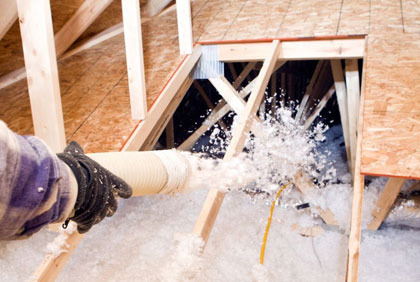Insulating an attic roof can be tricky using conventional insulation methods such as batt and blown in insulation. For starters, they can become a hassle for existing homes because the attic roof sheets will have to be torn down. This messy and time-consuming job is unattractive to most homeowners.
As one of the top attic insulation companies in Toronto, we are here to tell you fear not, there’s another type of insulation called blown-in insulation that addresses this issue. When it comes to insulating attic roofs, there’s no better option than that. Blown-in insulation is a great cost effective alternative for improving any home’s R-value.
What is Blown-in Insulation?
Blown-in insulation refers to the process of filling the cavities of wall studs, ceiling frames, or attic roofs with a loose material that has a high R-value, typically R60. The most common material used for blown-in insulation are loose-fill fiberglass and cellulose. Loose-fill fiberglass are usually packaged in large bags. These tiny chunks of fiberglass is blown using a blower machine that spreads the chunks all over the cavities and tight spaces. On the other hand, blown-in cellulose is made up of recycled cardboard or newspaper that are chemically treated to resist fires and mold. Cellulose is designed with eco-friendliness in mind and for these reasons, is often the blown-in insulation choice of most homeowners. When installing blown-in insulation, you do not generally need to remove the ceiling drywall which saves quite a bit of work.

Other types of attic insulation
Aside from blown-in insulation, conventional insulation methods is another alternative for attic insulation. Despite their hard nature to be installed, they aren’t entirely impossible to do so. And along with their attractive properties such as eco-friendliness, high R-values like R60 insulation, and durability, these other types of insulation can be a great alternative for insulating your attic.- 1. R60 Batt Insulation Batt insulation is by far, the most popular alternative for insulating attic roofs. These fiberglass composed of recycled material looks exactly like cotton candy. They usually take the form of large rolled-up sheets held together by an adhesive with vapor resistant properties. Fiberglass batt insulation is renowned for its high moisture resistance, making it virtually immune to molds and mildew. Its packaging and custom pre-cut panels makes the installation process more convenient, though you still have to tear down the ceiling drywall boards which is the only inconvenience for renovations.
- 2. Spray Foam Insulation Spray foam insulation is another great option for insulating existing homes. Its ability to expand from its liquid state to as much as 30 times its volume makes it ideal for insulating hard to reach areas in your attic roof. It also has excellent insulating properties, thanks to its porous nature that can resist water seepage to some extent. When it comes to durability, it has high mechanical strength that doesn’t easily sag.
Benefits of blown-in insulation
Blown-in insulation is perfect for re-insulating your attic roof where there is already existing drywall in the ceiling. It eliminates the need for tearing down existing boards. It can also seal small gaps and spaces as it settles, thus filling crucial spots where cold air otherwise come in. Blown-in insulation is generally considered to be much cheaper than other types of insulations. It can exceed expectations provided that it’s installed properly in the correct places and the material used is of high-quality.

